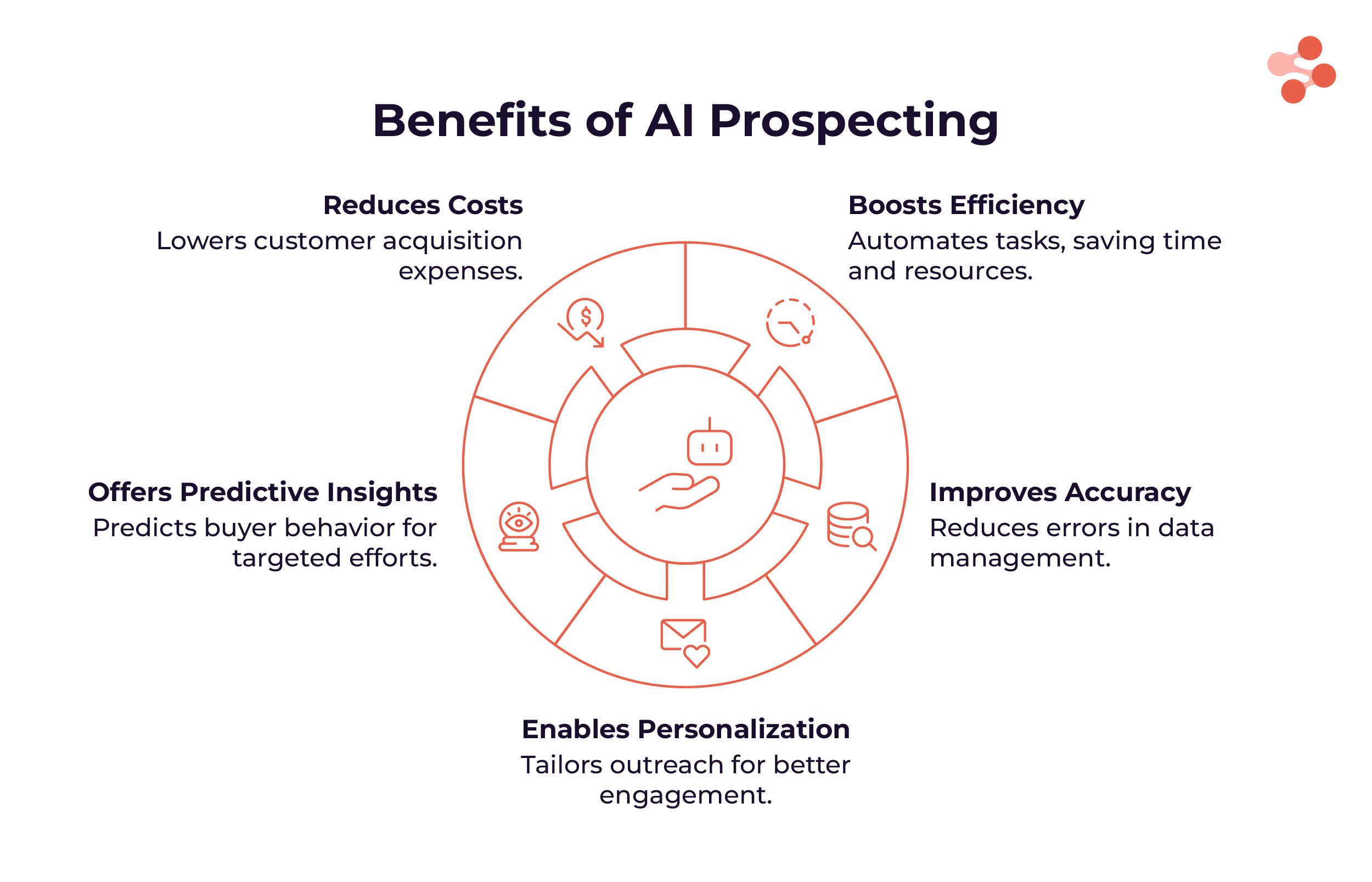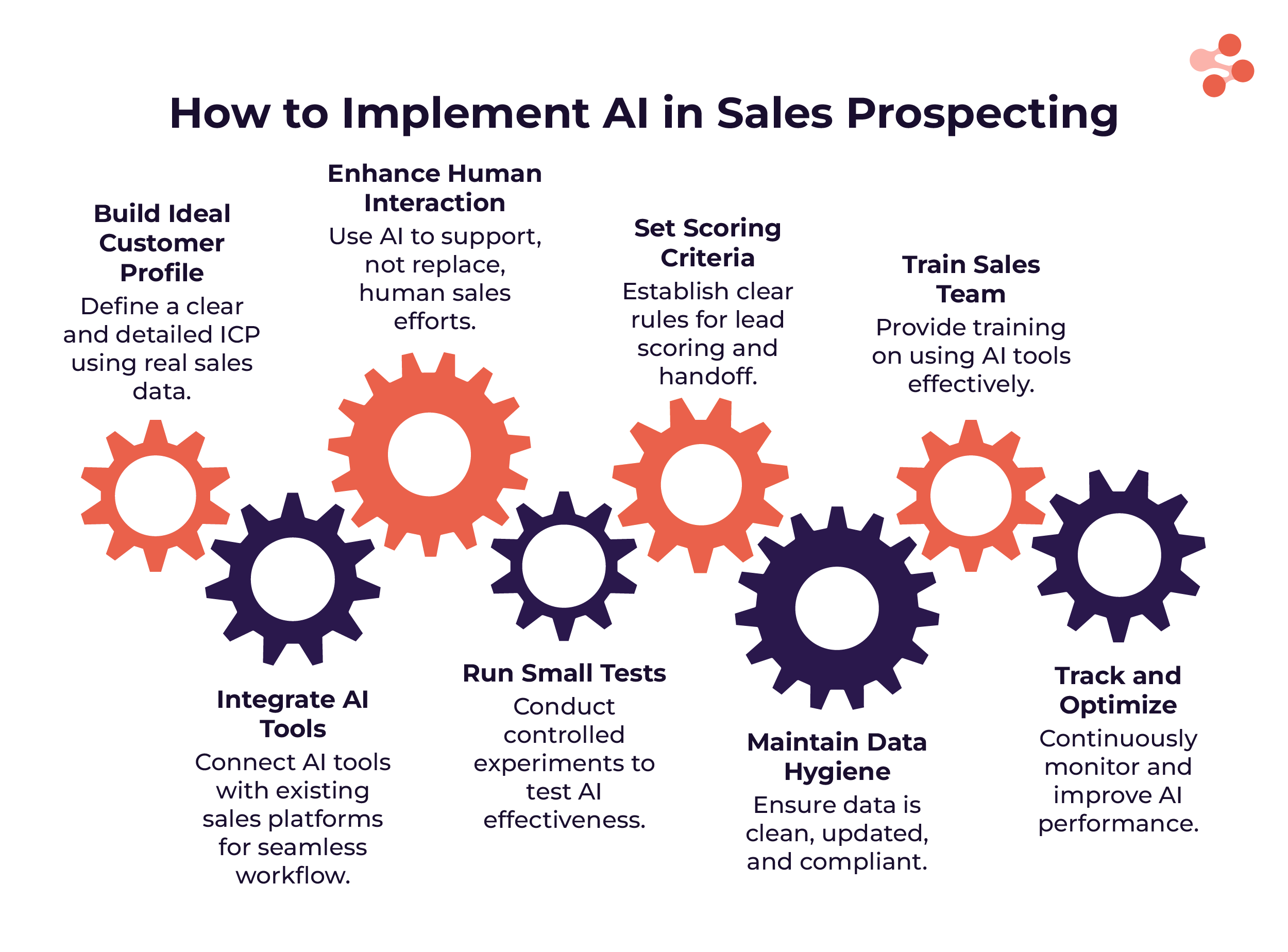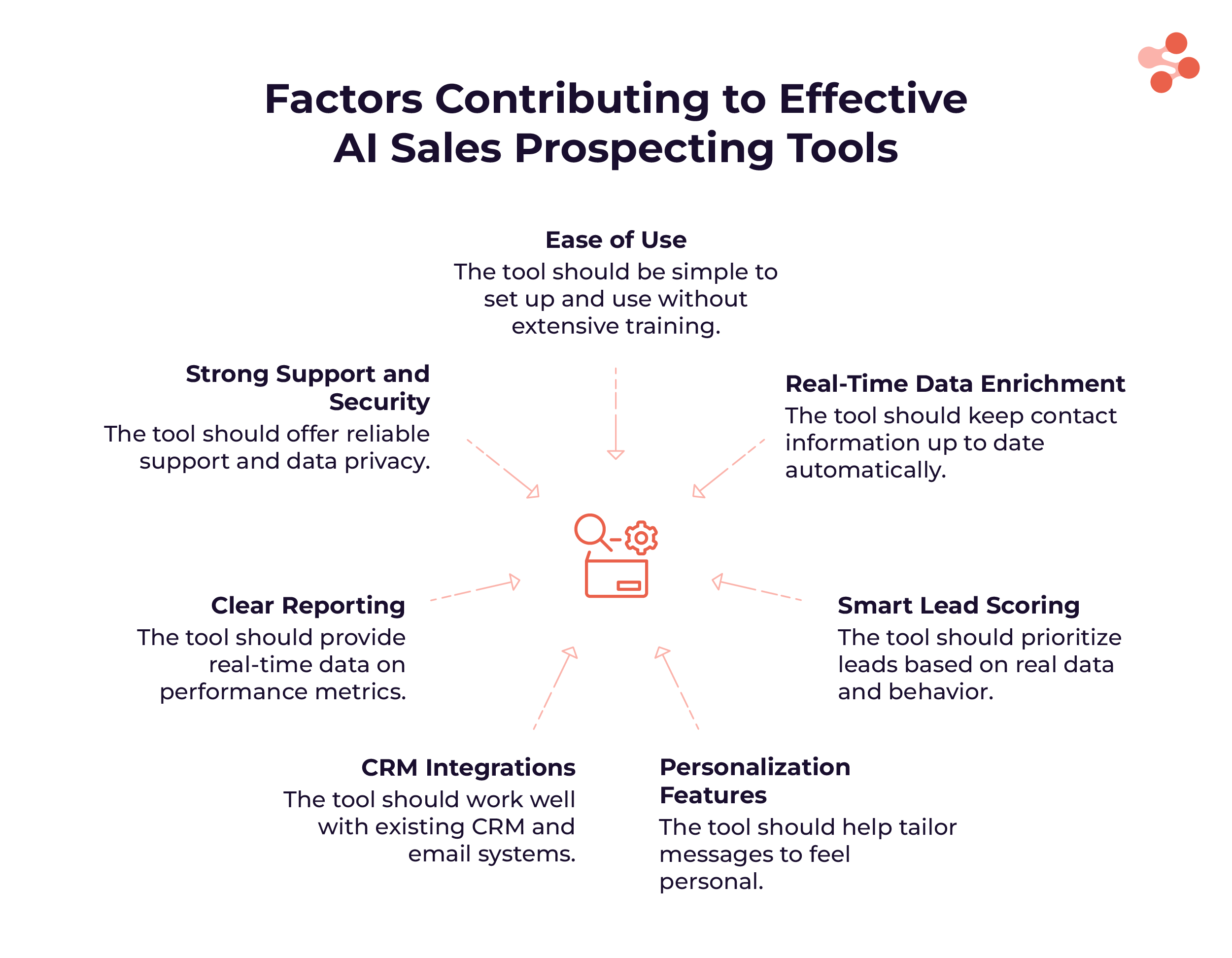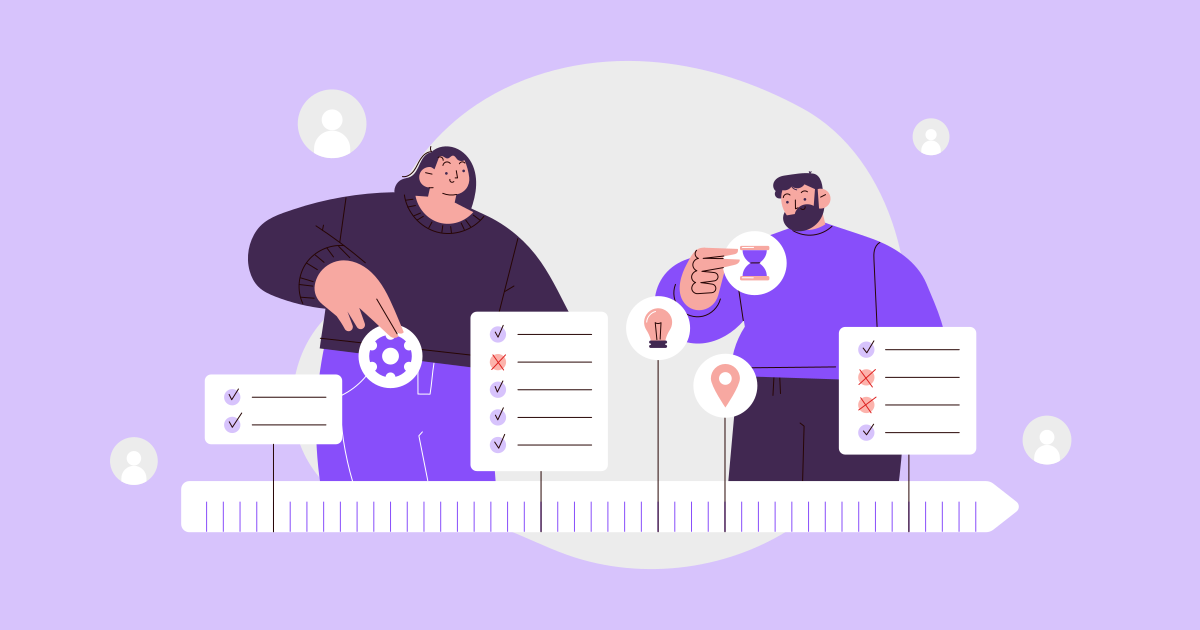Table of content
Prospecting today isn’t what it used to be.
Manual research, scattered spreadsheets, and endless cold outreach waste valuable hours. Even the best reps end up chasing leads that were never a good fit to begin with.
The result? Slower pipelines, lower response rates, and missed opportunities.
That’s where AI sales prospecting changes the game.
With the right tools, you can identify high-intent leads, personalize outreach at scale, and focus your time on what actually moves deals forward.
In this guide, we’ll break down everything you need to know about using AI in sales prospecting.
You’ll discover its key benefits, real-world use cases, step-by-step implementation tips, and the best AI prospecting tools to use in 2026.
What Is AI Prospecting?
AI prospecting is the modern way to find and reach high-quality leads. It uses artificial intelligence to replace guesswork with data-backed decisions.
Instead of digging through spreadsheets or cold lists, AI tools scan real-time data. They look at firmographics, technographics, buying signals, and past engagement. This helps your team focus only on leads that are worth their time.
AI builds your Ideal Customer Profile by analyzing who is buying, why they buy, and what triggers their decisions. It helps you get clear on who to target and when.
Once that profile is in place, AI scores and ranks leads based on how likely they are to convert. The best prospects rise to the top, so your team doesn’t waste time on low-intent contacts.
Outreach becomes more personalized. AI uses details like job title, company size, and past behavior to craft messages that feel relevant. Your emails land better, your replies go up, and your deals close faster.
It also handles the busywork. Tasks like follow-ups, CRM updates, and data entry are automated. That gives reps more time to focus on real conversations and pipeline growth.
In simple terms, AI prospecting brings speed, focus, and precision to your sales process. It helps you work smarter, connect faster, and close stronger.
Key Benefits of AI Prospecting
AI sales prospecting is not just a time-saver. It transforms how sales teams work—making every step smarter, faster, and more targeted. Here’s how it helps.

1. Boosts Efficiency
AI cuts down hours of manual work. It pulls data from multiple sources, filters it, and surfaces the best leads. Sales reps no longer waste time researching or updating spreadsheets. Some teams report up to 80% time saved just by automating lead research and follow-ups.
2. Improves Accuracy
Bad data kills deals. AI tools reduce human error by auto-filling and syncing contact details, company info, and buying signals. It ensures your database stays clean and current. Accurate data means better targeting and fewer bounced emails.
3. Enables Personalization at Scale
Generic messages don’t get replies. AI sales prospecting tools help tailor outreach based on role, industry, pain points, and behavior. Reps can send personalized emails and LinkedIn messages in minutes, not hours. This leads to higher engagement and better conversion rates.
4. Offers Predictive Insights
AI doesn’t just organize data—it makes sense of it. By tracking patterns in buyer behavior, it scores leads and predicts who is ready to buy. This helps teams focus on high-intent prospects and prioritize outreach more effectively.
5. Reduces Customer Acquisition Costs
Smart targeting leads to fewer wasted touches. Some companies report up to 45% lower customer acquisition costs after switching to AI prospecting. By identifying high-fit leads early and automating follow-ups, CAC drops and ROI improves.
Top Use Cases of AI in Sales Prospecting
AI is not just a trend in B2B sales—it’s changing how outbound prospecting gets done. Below are four real-world use cases where AI tools improve targeting, personalization, performance, and lead quality.
1. Find High-Intent B2B Leads Faster
The first challenge in prospecting is knowing who to reach out to. AI solves this by scanning large volumes of data and detecting patterns in your existing pipeline. It studies past deals—both won and lost—to understand what makes a lead valuable.
This includes firmographic data like company size, industry, and revenue. It also tracks behavior signals like content engagement, website visits, and technology used. Based on these insights, AI tools suggest new leads that closely match your best customers.
This means you don’t waste time chasing cold or low-fit accounts. Instead, you spend more time talking to people who are most likely to convert.
2. Score and Prioritize Prospects with Accuracy
Traditional lead scoring was based on assumptions. Sales teams would assign points for actions like attending webinars or downloading eBooks. But there was no real proof that one action mattered more than another.
AI-powered lead scoring changes that.
It uses machine learning to analyze real outcomes from your sales data. By comparing closed-won and closed-lost deals, it identifies the signals that actually predict a sale. Then, it assigns each lead a dynamic score based on these real buying patterns.
This score isn’t static. It updates as the lead’s behavior changes. Once a lead hits a certain score, your team can be alerted for fast outreach. You can also route leads based on thresholds, regions, or sales rep strengths.
This way, your team always knows who to prioritize—and when to act.
3. Personalizing Sales Outreach
Personalized outreach works better. Everyone knows that. But writing personalized emails at scale has always been a problem.
Sales reps don’t have time to craft one-on-one messages for hundreds of contacts. Most end up sending bland, cookie-cutter templates.
That’s where AI comes in.
AI tools can write cold emails, LinkedIn messages, and even cold calling scripts that feel human and relevant. They pull from public data, CRM activity, and past behavior to make each message tailored to the recipient.
Some sales teams use ChatGPT and similar tools to draft first-touch messages, follow-ups, and even competitor battle cards. It helps them save time while improving response rates.
AI doesn’t just write content. It also learns what works. If a subject line drives higher open rates, or a message format gets more replies, the system can replicate that success across future campaigns.
4. Optimize Sales Performance with AI Insights
AI doesn’t stop at outreach. It helps after the message is sent, too.
Sales leaders need data to guide decisions. AI helps by tracking open rates, reply rates, call connects, and conversions across different channels. But more than that, it finds patterns in the data—what type of messaging leads to meetings, what times work best, and which reps are performing above average.
It can A/B test messages automatically and suggest changes based on performance. For example, if a certain cold email angle leads to more booked meetings, the AI tool can recommend shifting more outreach in that direction.
It can also refine targeting. By constantly learning from past outcomes, AI can tweak your ICP, add new targeting filters, or help you remove unqualified accounts from your list.
The result? Smarter campaigns, better timing, and more closed deals.
5. Enhancing LinkedIn Prospecting
LinkedIn is one of the top platforms for B2B prospecting. But manual LinkedIn outreach can be slow and inconsistent.
AI tools now help automate and optimize LinkedIn prospecting by identifying high-intent profiles, suggesting personalized messages, and tracking engagement.
You can sync LinkedIn activity with your CRM, trigger follow-ups based on profile visits, or personalize connection requests at scale. This turns LinkedIn into a high-performing outbound channel without burning hours on manual research.
How to Implement AI in Sales Prospecting the Right Way
Adding AI to your sales prospecting process isn’t just about using new tools. It’s about building a system that improves accuracy, speed, and lead quality—without losing the human touch. Here’s how to do it right.

1. Build a Strong Ideal Customer Profile (ICP) First
AI is only as effective as the data you feed it. Before you plug in a sales prospecting tool, define a clear and detailed Ideal Customer Profile.
Use real sales data from closed-won deals. Look at firmographics (like company size, industry, region) and behavior patterns (like buying cycles, content engagement, and sales touchpoints). Make sure your ICP is based on facts, not assumptions.
A clean ICP gives AI a solid foundation to target the right accounts. Without it, your prospecting list will be off-target no matter how smart the algorithm is.
2. Integrate AI Tools with Your Sales Stack
For AI to support your workflow, it must connect with the platforms you already use—CRM, marketing automation, email, and LinkedIn.
Ensure your AI prospecting tool can sync with Salesforce, HubSpot, Outreach, or whichever platform your team relies on. This way, your sales reps get real-time insights inside the tools they use daily.
A connected system also makes it easier to track lead scores, automate tasks, and trigger follow-ups based on real-time engagement.
3. Use AI to Enhance, Not Replace, Human Interaction
AI can suggest who to target, what to say, and when to follow up. But your sales team still builds the relationship.
Let AI handle the heavy lifting—research, data enrichment, scoring, and first-draft outreach. But give reps the power to fine-tune messaging and use emotional intelligence during calls, demos, and negotiations.
AI is great at spotting patterns. Humans are better at creating trust and closing deals. Combining both gives you a major edge in B2B sales prospecting.
4. Run Small Tests Before Scaling
Don’t expect AI to fix everything on day one. Start small.
Run controlled experiments with short prospecting cadences. Test different email styles, lead score thresholds, or outreach times. Track key metrics like open rates, response rates, meetings booked, and conversions.
Use those insights to adjust and improve. Once you see results, scale the best-performing approach across your team.
AI tools get smarter with time and data—but only if you give them feedback loops.
5. Set Clear Scoring Criteria and Handoff Rules
AI lead scoring only works if your team understands what the scores mean.
Set clear rules. For example: “Any lead with a score over 80 gets routed to a sales rep,” or “Marketing handles leads under 50 until they reach a higher intent level.”
Define triggers that move leads through the funnel—like visiting your pricing page, replying to an email, or attending a webinar.
This keeps your pipeline moving smoothly and ensures reps spend time on the right leads.
6. Keep Your Prospecting List Clean and Compliant
A powerful AI system means nothing if your data is messy or outdated.
Use AI to automatically verify emails, phone numbers, and company details. Regularly enrich records with updated job titles, firmographics, and LinkedIn activity. This prevents bounce backs, saves time, and keeps your outreach compliant with GDPR and other data laws.
Make list hygiene part of your weekly or monthly sales operations checklist.
7. Train Your Team to Use AI Effectively
Sales reps aren’t data scientists. If you want them to succeed with AI tools, train them.
Show how to interpret lead scores, use templates properly, personalize outreach based on insights, and trust AI-driven suggestions without depending on them blindly.
Make AI a core part of your sales onboarding process and give your team ongoing support as they adjust.
8. Track Performance and Keep Optimizing
AI is not a one-time setup. It needs ongoing input and evaluation.
Track how AI-driven prospecting performs over time. Look at reply rates, deal sizes, and time-to-close. Review what messaging works best or which lead sources deliver the most value.
Then fine-tune your ICP, outreach strategy, and scoring logic as needed. AI gets stronger when you treat it like a living part of your sales engine—not a set-and-forget tool.
AI Prospecting vs Traditional Prospecting: What’s the Difference?
Sales prospecting has come a long way. While traditional methods rely on manual effort and gut instinct, AI-powered prospecting brings speed, data, and precision into the process.
Here’s a side-by-side breakdown to show how they compare in the real world:
Traditional prospecting still works. Especially when a sales rep uses instinct and insight to navigate complex deals.
But manual research takes time. Updating spreadsheets, chasing cold leads, and guessing who to contact can drain hours from your day.
It’s slow. It’s scattered. And it doesn't grow with your team.
AI prospecting changes that. It cuts through the clutter. It finds the right leads, sends smarter outreach, and helps reps focus on closing.
Think of it like a digital sales assistant. It never forgets to follow up, never needs a break, and always works with clean data.
For growing sales teams, AI is no longer optional. It's how modern prospecting gets done.
Use it well—or risk falling behind those who do.
Common Mistakes to Avoid When Using AI for Prospecting
AI can boost your prospecting game. But only if you use it the right way. Here are the most common mistakes that trip up sales teams—and how to avoid them.
1. Relying Only on AI
AI is smart. But it’s not perfect. It can surface great leads, but it can’t build relationships. Don’t forget the human part. Reps still need to follow up, ask good questions, and listen.
Use AI to guide the process, not run it alone.
2. Using Bad Data
If your data is old or wrong, your results will be too. AI depends on clean, updated info to do its job well.
The problem? Data goes bad fast. People change jobs. Companies shut down. This is called data decay—and it happens every day.
Make sure your CRM stays fresh. Verify emails, job titles, and company details often. The better your data, the better your outreach.
3. Over-Automating Outreach
Too much automation makes your messages feel cold. People can tell when an email isn’t written for them.
Use AI to write first drafts. But always review and tweak for tone, timing, and relevance. Keep it human.
4. Ignoring Lead Scores
Your AI tool gives each lead a score for a reason. If you ignore those scores, you’re wasting its full value.
Set clear rules. If a lead crosses a score threshold, take action. Don't let hot leads cool off.
5. Skipping Testing and Feedback
AI needs feedback to get better. If you never test or measure, you won’t improve.
Try different approaches. Track what works. Then adjust based on results. The more you test, the smarter your system becomes.
6. Forgetting to Train Your Team
AI tools are only helpful if your team knows how to use them. Don’t assume everyone gets it on day one.
Offer training. Share tips. Show them how to use the insights in real deals. A confident team gets more from the tech.
Avoid these mistakes and AI won’t just save time—it’ll help you win more deals.
What Makes a Good AI Sales Prospecting Tool?
Not all AI tools are built the same. Some just add automation. Others truly improve how your team finds and connects with leads.
Here’s what to look for in a tool that actually helps your sales team win.

1. Easy to Use
A good AI tool should be simple to set up and easy to use. If your team needs hours of training just to send an email, it’s not the right fit.
Look for clean dashboards, clear features, and helpful prompts. Your reps should be able to use it without asking for help every time.
2. Real-Time Data Enrichment
Prospecting only works when your data is right. A strong tool will keep contact info up to date, fill in missing fields, and catch job changes as they happen.
It should check and refresh your data automatically, not leave you guessing.
3. Smart Lead Scoring
You want to know which leads are worth your time. A good tool does this using real data from your pipeline—not just guesswork.
It should adjust scores based on behavior, timing, and fit. That way, your reps can focus on the right people at the right time.
4. Personalization Features
The best outreach feels personal, not robotic. Your AI tool should help you tailor messages fast—using job roles, company info, and past behavior.
Bonus if it can write cold emails, LinkedIn messages, and follow-ups that sound human.
5. CRM and Tool Integrations
Your AI prospecting tool should work well with the tools you already use. That includes your CRM, email platform, and LinkedIn.
If it can’t talk to your systems, it slows you down instead of speeding you up.
6. Clear Reporting and Insights
You need to know what’s working. Look for tools that show open rates, response rates, and conversion data in real time.
This helps your team adjust fast, spot trends, and improve results over time.
7. Strong Support and Security
Choose a vendor that offers fast support and takes data privacy seriously. You’re working with customer data, so security matters.
Ask about compliance, storage, and how your data is used.
Best AI Sales Prospecting Tools in 2026
Here’s a curated list of the top AI tools that are changing how B2B teams build prospecting lists, enrich leads, and close deals faster
1) SMARTe
SMARTe is a sales intelligence and B2B data enrichment platform built for global prospecting. It offers real-time enrichment, highly accurate mobile numbers, and a powerful contact database. It helps GTM teams target the right accounts, enrich CRM records, and build qualified lead lists—fast.
Key Features
- 281M+ verified B2B contacts across 190+ countries
- 65M+ company profiles and 59K+ technographic filters
- Real-time enrichment and lead scoring
- High mobile number coverage (Up to 70%)
- Chrome extension for LinkedIn and web prospecting
- Native integrations with Salesforce, HubSpot, and more
Pros
- Delivers clean, accurate contact data
- Fast ZoomInfo alternative with high global coverage
- Easy CRM enrichment with real-time updates
- Ideal for ABM, SDRs, and enterprise sales teams
Cons
- Might feel complex for very small teams
Pricing
SMARTe follows a credit-based pricing model with no hidden user license costs and unlimited team access.
- Free Plan: 10 credits per month at no cost. No card required.
- Pro Plan: $25 for 50 credits per month ($0.50 per credit).
- Enterprise Plan: Starts at $15,000. Pricing begins at $0.30 per credit, dropping with scale. At 1M credits, the rate is $0.20 per credit, with room for further discounts on higher volumes.
2) ZoomInfo Copilot
ZoomInfo Copilot is the AI layer on top of ZoomInfo’s core platform. It brings generative AI and automation into the sales workflow—turning data into actions. It's especially strong in ZoomInfo enrichment, workflow orchestration, and AI recommendations.
Key Features
- Uses ZoomInfo’s database for enrichment and automation
- AI playbooks for outbound campaigns
- Writes personalized emails with GenAI
- CRM sync and pipeline task automation
- Helps SDRs and AEs prioritize leads faster
Pros
- Deep ZoomInfo enrichment for contacts and accounts
- Saves hours with AI-driven workflows
- Built-in email writer speeds up outbound
- Strong intent data and firmographic filters
Cons
- Requires existing ZoomInfo subscription
- Can be costly for small teams
Pricing
- Add-on pricing on top of ZoomInfo subscription
- Custom quotes only
3) Artisan
Artisan is an AI sales prospecting platform built for speed and personalization. It automates your entire outreach workflow—from finding leads to writing emails—using its massive contact database and smart AI tools.
Key Features
- 300M+ verified B2B contacts in a proprietary database
- Automated lead research and data enrichment
- AI writes and personalizes email content
- CRM integration for smooth syncing
- AI playbooks that guide your outreach
- Dedicated onboarding and custome support
Pros
- Cuts down manual work with full automation
- Personalized outreach boosts response rates
- Fits both startups and large teams
- Contact data is accurate and fresh
Cons
- No fixed pricing; you need a quote
- Might feel complex for very small teams
Pricing
- Quote-based pricing; a free trial is available
4) Seamless.AI
Seamless.AI is built for sales teams that need real-time data. It helps you find and verify leads fast. The platform uses AI to recommend contacts and personalize your outreach.
Key Features
- Builds lead lists in real time
- Verifies contact data with AI
- Offers buyer intent signals and pitch suggestions
- Automates outreach and list-building tasks
- Generates copy using AI
Pros
- Contact data is fresh and accurate
- Saves time on research
- Intent data helps prioritize hot leads
Cons
- Can be costly for small teams
- Advanced features may take time to learn
Pricing
- Starts at $147/month; free trial available
5) Apollo
Apollo is an AI-driven sales platform that combines data, automation, and predictive tools. It’s built to help sales teams connect with the right people across multiple channels.
Key Features
- 275M+ verified contacts and 60M+ company profiles
- AI email assistant for personalized outreach
- Smart lead scoring based on behavior and intent
- Runs campaigns across email, phone, and LinkedIn
- Sales intelligence and reporting tools
- CRM integrations for seamless syncing
Pros
- Huge contact database with verified info
- Predictive targeting boosts efficiency
- Multi-channel campaigns improve reach
Cons
- Some tools are locked behind higher plans
- The dashboard may feel crowded for new users
Pricing
- Custom pricing based on your plan and team size
6) Overloop.ai
Overloop.ai is a sales automation platform that focuses on outbound prospecting. It finds prospects, personalizes messages, and manages campaigns across channels—all powered by AI.
Key Features
- AI finds leads that match your ideal customer
- Writes hyper-personalized emails automatically
- Runs campaigns on email, phone, and LinkedIn
- Tracks engagement in real time
- Suggests the best follow-up actions
Pros
- Saves hours on prospecting and writing
- Increases replies with targeted messages
- Simple, clean interface
Cons
- Fewer integrations than bigger platforms
- Advanced insights need a premium plan
Pricing
- Custom quote required; a free trial is available
7) Clay
Clay is an AI tool for data enrichment. It keeps your CRM clean and accurate. Clay enrichment adds fresh contact data in real time. Waterfall enrichment fills in missing info using multiple trusted sources.
Key Features
- Enriches CRM records in real time
- Auto-updates contact info without manual input
- Uses AI to qualify and score leads
- Connects easily with your CRM
- Custom workflow automation
Pros
- CRM stays updated and accurate
- Saves time by cutting data entry
- Workflows are flexible and easy to scale
Cons
- More expensive than some tools
- Custom setup can take time
Pricing
- Starts at $134/month; free trial available
Conclusion
AI is changing the way sales teams find and connect with leads.
What used to take hours can now happen in minutes—with better results. From building smarter prospecting lists to writing personalized outreach, AI takes care of the heavy lifting.
But tools alone won’t close deals.
You still need smart strategy, clean data, and a strong message. Use AI to speed things up, not replace real sales conversations.
Start small. Test what works. And choose tools that match your team’s workflow.
The future of sales prospecting is here—and it’s powered by AI.









